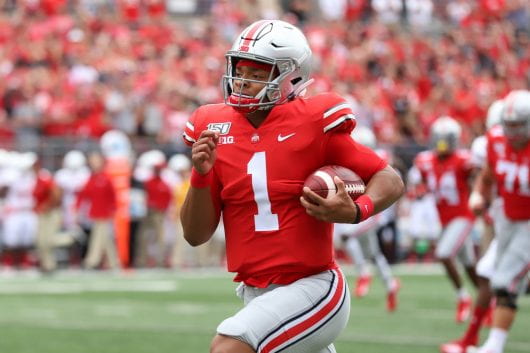
Ohio State sophomore quarterback Justin Fields (1) makes a run to make the first touchdown of the game during the first half of the game against Florida Atlantic on Aug. 31. Ohio State won 45-21. Credit: Amal Saeed | Photo Editor
The Spring Game is an annual oasis for fans left dried out from a three-month college football drought, but there was no such satiation in Columbus, Ohio, Saturday.
In a town where a national record-setting six-figure crowd gathered to watch Ohio State’s glorified scrimmage just four years ago, there wasn’t one to be found in the stands at Ohio Stadium during the exhibition’s originally scheduled April 11 date.
With sports on an indefinite worldwide hiatus, fans would have welcomed even the most half-hearted gridiron demonstration, but disappointed Buckeye supporters can take solace in the fact that the events of the Spring Game often carry little to no weight in determining the course of the season for any particular player.
Look no further than the game’s latest edition for proof.
Junior quarterback Justin Fields’ most underwhelming performance at Ohio Stadium thus far didn’t come in a regular-season game in 2019, when he attained a 19-to-1 touchdown-to-interception ratio and completed 68 percent of his passes. Rather, it was his mediocre Spring Game outing that proved to be his most head-scratching.
Outside of a 98-yard catch-and-run touchdown toss to then-senior wide receiver Binjimen Victor, Fields finished 3-for-12 with 33 yards passing. His final completion percentage was 24 percent lower than any game he had in 2019, a campaign that saw Fields account for less than three touchdowns in a game just once prior to the Fiesta Bowl.
The out-of-sync April showing was a departure from Fields’ 51-touchdown first year in the program, which earned him a third-place finish in the Heisman Trophy vote eight months after his debut in the ’Shoe.
A similar story unfolded the year prior, when the Spring Game played host to a three-man quarterback battle to help decide who would take the mantle for long-time starter J.T. Barrett.
Dwayne Haskins hardly stood out from the pack with a 120-yard performance on 9-of-19 passing in the 2018 exhibition. In fact, Joe Burrow outdid him on the cards with a 15-for-22, 238-yard game with two touchdowns.
The outcome clearly didn’t dictate the subsequent depth chart though, as Burrow packed his bags for Baton Rouge, Louisiana, and Haskins wound up in New York as a Heisman finalist that December following a record-setting 50-touchdown, near-5,000 yard season.
Haskins averaged 225 more yards per game passing throughout the season than he threw for in the 2018 Spring Game and had only two games during the season in which his completion percentage was within 15 percent of his April exhibition.
But the pendulum can also swing in the opposite direction, when a breakout performance in the Spring Game sets up high hopes before a lackluster season come fall.
Such was the case for then-sophomore running back Demario McCall in 2017. McCall made a number of big plays in the Spring Game, chewing up 83 yards on the ground on just six carries and adding 48 more and a touchdown on two catches.
McCall’s speed and versatility as a tailback and pass catcher proved why he was a top 50 high school prospect in the country the year prior, but he accrued just 31 more yards from scrimmage during the 2017 season than he had in the Spring Game before being redshirted.
Perhaps more disappointing is that in the two years since, McCall has failed to reach the total yardage mark he attained in just three games during his redshirt 2017 campaign.
The common thread is that few people even remember these performances due to their less-than-predictive nature and the fact that the Spring Game is a mostly forgettable affair overall.
Although it seems less likely by the day, if the 2020 college football season goes on without a hitch and the Spring Game is played next April, fans may forget they ever missed this one in the first place.


